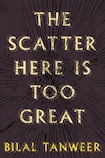
‘Nothing I wrote was up to the task of capturing this ruinously mad city.” A character in Bilal Tanweer’s debut novel details the frustrations of an aspiring writer. Now a sub-editor, he finds solace in “the continual relief of completing small tasks”.
Where his characters fail, the author succeeds in depicting his native Karachi. An honorary fellow of the international writing programme at the University of Iowa, Tanweer has seen his fiction and poetry anthologised in Granta and Words Without Borders. In The Scatter Here Is Too Great he shows that there is no one true story behind a city as populous and discordant as the Pakistani capital. The interwoven narratives of his short novel instead offer a platform to its inhabitants.
Reeling after a bomb blast at a central train station, the sub-editor believes that “there was nothing called true stories. Only fragments were true”. Voices are adrift in the wake of such violence and Tanweer weaves them together again, both thematically and literally, in a complex narrative that showcases the destruction brought about by terrorist acts.
One of the most memorable characters is introduced in the opening sequence, a young boy in trouble in school for fighting. His outbursts are a reaction to taunts, relayed with a childlike logic that is both funny and heartbreaking: “I have protruding teeth and because of this everyone at school called me parrot, parrot.”
Within this story, we meet Comrade Sukansaz, a communist poet who has chosen his cause above his family. This cause has proved futile. He is a relic, wandering the city regretting his choices, harassed by teenagers as he tries to make himself heard. The geopolitics are outlined starkly by an onlooker: “That general Zia, that dog of the CIA, he ate them all up.”
Other characters are equally despairing about their prospects in modern Pakistan. Sadeq works a dead-end job offloading repossessed cars to unsuspecting buyers. His new relationship is short-lived when the girl’s grandmother catches them kissing in a hallway. Her shock is a reminder of the restricted lives of women in Pakistan. To a western reader, it is like entering a bygone era.
The sea at the city’s periphery washes away the madness and grime. After the young boy and his beloved father from the opening chapter are held at gunpoint on a bus, they reach the coast: “We sat on the shore and watched the waves that came so slowly.” Buses are dangerous places. Old men are harassed, violence is commonplace, a journalist is coerced into an interview by a character known as the Bird of Death.
A sense of doom hangs over the novel. A wealthy businessman is paralysed with fear after the explosion, wondering how to help his mother and an elderly friend: “It tastes like a cold blunt knife in your mouth. It doesn’t cut. Worse is yet to come.”
Fear personified
This fear is personified later on by two men in long pink robes, one of them the Bird of Death, who roam among the dead at the bomb site: “Bald heads, and their tongues were sharp and elongated and hung down to their chins.” The ambulance worker who witnesses this believes they are Gog and Magog, harbingers of the apocalypse.
Generations disappoint each other and are estranged. Comrade Sukansaz seeks forgiveness from his son, the businessman, but childhood betrayals have cemented to adult resentment. The son has made his fortune in the gaming industry and his motto for successful living is inspired by Pacman: “Get the dots, avoid the ghosts, move up one level and absolutely no pauses whatsoever.”
This motto has not saved him from losing his own family after an affair. Two years on, his son still refuses to see him. We have met the son earlier as he courts a young woman in secret. Connections like this crop up throughout the novel and are satisfying for the reader.
Other characters yearn for fathers they cannot reach. A writer grieving for his dead father can’t articulate his pain. The healing power of narrative is a recurring theme. From the Comrade’s poetry, to his son’s rewriting of history, to a young woman’s bedtime tales, the characters tell their stories in the face of incomprehensible violence and loss.
With all these fathers and sons and illicit courtships of nameless characters, the book’s meandering is at times confusing and disjointed. The voices that are most affecting – ‘parrot, parrot’, Sadeq and his truant friend, the businessman son – invite us into their lives. Elsewhere there are only snippets, insights that ring true but are lost amid the cacophony.
As the sub-editor comes to realise, these are not enough: “Fragments were true; but we needed stories greater than fragments. We needed stories in order to imagine the mad world we lived in.”













